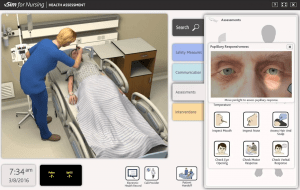During spring 2020, as COVID-19 increased its foothold in the United States and in Shelby County of Memphis, the University of Memphis quickly transitioned to remote teaching and learning for safety and health of all students, faculty, and staff.
In the Loewenberg College of Nursing, Prof. Nathan Knappier led to leverage existing technology, identify new solutions to support student learning and faculty teaching especially when the clinical sites were closed to students.
Knappier said when most of the practice settings noted no students to clinical in spring 2020, it became clear that simulation would play a more active role in the education of students. The simulation had to be effective for multiple programs at the bachelor and master level. For the undergraduate student population, it was decided that it was important to acquire an online virtual simulation program because, at that time, the campus had closed to student use as well.
“vSim® for Nursing helps provide students with important clinical experience through virtual simulation. It provides realistic encounters with virtual patients to help students gain health assessment, clinical reasoning and decision-making skills for patient-centered care across the lifespan.” Knappier said.
During simulations, students have a virtual patient whose chart they can review. They can look at the patient’s eyes, mouth, check the vitals, administer medications and perform a variety of tasks with the patient. Students are provided immediate feedback when the patient scenario ends.
“From an education standpoint, using structured simulation, students get immediate feedback, which enhanced their learning.” Knappier said.
At the end of the spring semester, faculty and students were surveyed to determine if the implementation of the Vsim was successful. Ninety-five percent of faculty said vSim was a good experience and they would like to use it again. Seventy-eight percent of the students felt future students would benefit from using the software. The feedback from faculty and students helped continue using Vsim for when this fall education is delivered through a hybrid approach amid COVID-Pandemic.
Because of the rapid change to online learning and the sheer number of students and courses that needing to move to a different method/platform, Knappier said he would continue conducting training or having workshops, allowing users to get answers to questions or share concerns.
“This happened so fast. We just had to jump in and do it. I was nervous about how faculty would experience that rapid of a change and how the students would adapt. I was very pleased with just how flexible, how adaptable everyone was. Everyone knew we were all in the same boat, so I think everyone just had a really good attitude about it and that was the key to its success,” he said.





